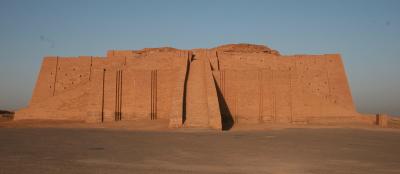Basic international humanitarian law (IHL) rules applicable to this situation:
Each party to the conflict must respect cultural property; special care must be taken in military operations to avoid damage to buildings dedicated to religion, art, science, education or charitable purposes and historic monuments unless they are military objectives. Property of great importance to the cultural heritage of every people must not be the object of attack unless imperatively required by military necessity.
Each party to the conflict must protect cultural property; all seizure of or destruction or wilful damage done to institutions dedicated to religion, charity, education, the arts and sciences, historic monuments and works of art and science is prohibited.
The case in brief
The Ziggurat, in the city of Ur, is among Iraq’s most prized ancient sites. It was designated as a World Heritage Site by the United Nations in 2016.
During the Gulf War of 1990–91, the United States of America (US) participated in a coalition against Iraq in response to Iraq’s invasion of Kuwait. Conducting the conflict in line with IHL rules was considered essential to maintaining public support for the mission.
In compliance with its targeting policy and core IHL principles of distinction and proportionality, the US military took various measures to avoid collateral damage to cultural property during the conflict, including choosing not to attack Iraqi aircraft positioned close to the Ziggurat.
IHL compliance highlights
- To support its strike planners in minimizing the risk to Iraqi cultural property, US Central Command developed a list of sites that were not to be targeted. Strike planners:
- reviewed targets to identify nearby cultural property and highlighted any such property as ‘non-targets’ on maps
- selected aircraft and weapons that offered maximum accuracy
- directed aircrews attacking targets close to cultural property not to fire if they deemed the risk of collateral damage too high.
- On one occasion, the US opted not to attack two Iraqi fighter jets positioned next to the Ziggurat, calculating that the site was too significant to justify potential incidental damage.
- In 1993, when reporting to the US Congress on its actions to protect cultural property in Iraq, the US Department of Defense stated its intention to pursue such efforts in compliance with IHL principles of military necessity and proportionality.
Case prepared by Dewi Alexandra Delf and Alexandra Bernard, LL.M. students at Leiden University, under the supervision of Professor Robert Heinsch as well as Alla Ershova (Senior Researcher) and Ashley Peltier (Researcher), Kalshoven-Gieskes Forum, Leiden University.
A. THE ZIGGURAT AT UR IS A WORLD HERITAGE SITE
[Source: ArchEyes, “Ziggurat Architecture in Mesopotamia”, 18 April 2016, available at https://archeyes.com/ziggurat-temples-architecture-mesopotamia/, accessed on 31 January 2021]
[…] The Ziggurat at Ur, a massive stepped pyramid about 210 by 150 feet in size, is the most well-preserved monument from the Sumerians’ remote age. It consists of a series of successively smaller platforms that rose to a height of about 64 feet and was constructed with a solid core of mud-brick covered by a burnt bricks thick skin to protect it from the elements. Its corners are oriented to the compass points, and like the Parthenon, its walls slope slightly inwards, giving an impression of solidity.
[…]
The ziggurat was part of a temple complex that served as an administrative center for the city, and it was also thought to be the place on earth where the moon god Nanna, the patron deity of Ur, had chosen to dwell. Nanna was depicted as a wise and unfathomable older man with a flowing beard and four horns, and a single small shrine to the god was placed upon the ziggurat’s summit. This was occupied each night by only one person, chosen by the priests from among everyone in the city. A kitchen, likely used to prepare food for the god, was located at the base of one of the ziggurat’s side stairways.
[...]
[Source: AP Archive, “Sumerian ruins gain UNESCO heritage status”, 21 August 2016, available at http://www.aparchive.com/metadata/youtube/d63e59c3b89b1c2f70166191bf3c518c, accessed on 31 January 2021]
The southern Iraqi city of Ur has been designated a World Heritage site by UNESCO.
Once the capital of Mesopotamia, Ur is home to ruins that date back more than 5 thousand years.
The ruins of the Ziggurat at Ur are among the city's most prized ancient sites.
Ur, considered to be one of the most important Sumerian capitals, has finally achieved UNESCO World Heritage status.
The city was the capital of Mesopotamia during the third millennium BCE.
[…]
''The ancient landmarks of the Ziggurat, the temples, the graveyard and other ruins helped us convince UNESCO to list the city of Ur as a World Heritage site," explains Qais Hussein Rasheed, undersecretary at the Iraqi Ministry of Culture.
[...]
B. THE US PUTS THE ZIGGURAT AT UR ON A NO-FIRE TARGET LIST AND PROTECTS THE WORLD HERITAGE
[Source: Final Report to Congress, ‘Conduct of the Persian Gulf War’, April 1992, pp. 132-133, available at https://apps.dtic.mil/dtic/tr/fulltext/u2/a249270.pdf, accessed on 31 January 2021]
[…] Planners [US] were aware that each bomb carried a potential moral and political impact, and that Iraq has a rich cultural and religious heritage dating back several thousand years. Within its [Iraq’s] borders are sacred religious areas and literally thousands of archaeological sites that trace the evolution of modern civilization. Targeting policies, therefore, scrupulously avoided damage to mosques, religious shrines, and archaeological sites, as well as to civilian facilities and the civilian population.
To help strike planners, CENTCOM [US Central Command] target intelligence analysts, in close coordination with the national intelligence agencies and the [US] State Department, produced a joint no-fire target list. This list was a compilation of historical, archaeological, economic, religious and politically sensitive installations in Iraq and Kuwait that could not be targeted. Additionally, target intelligence analysts were tasked to look in a six-mile area around each master attack list target for schools, hospitals, and mosques to identify targets where extreme care was required in planning. Further, using imagery, tourist maps, and human resource intelligence (HUMINT) reports, these same types of areas were identified for the entire city of Baghdad. When targeting officers calculated the probability of collateral damage as too high, the target was not attacked.
[…]
[Source: Lt. Col. John G. Humphries, ‘Operations Law and the Rules of Engagement, in Operations Desert Shield and Desert Storm’, Airpower Journal, Fall 1992 Vol. VI No. 3. available at https://www.airuniversity.af.edu/Portals/10/ASPJ/journals/Volume-06_Issue-1-4/1992_Vol6_No3.pdf, pp. 38-39, accessed on 31 January 2021]
[…] As the Desert Shield and Desert Storm operations showed, the rules of engagement reflect political and operational considerations that limit the application of military force. The coalition’s refusal to attack legitimate targets that were commingled with the Iraqi civilian populace and civilian objects was based on an amalgam of political and policy reasons. For instance, its decision not to strike military targets near cultural objects (e.g. the two MiG-21 fighter aircraft parked adjacent to the ancient temple at Ur) was based on respect for the cultural value of these objects. Although the law of armed conflict would have permitted their destruction, these aircraft—as well as the other Iraqi military hardware purposefully collocated among archaeological sites and cultural objects—remained on the coalition “Joint No-Fire Target List” because of the cultural value of the objects nearby and because the location of the aircraft effectively took them out of the fight.
[…]
Efforts to educate our personnel in the law of armed conflict have succeeded. Prosecuting the war legally while at the same time treating Iraqi soldiers and civilians humanely was essential to maintaining domestic and international public support. More importantly, it was the right thing to do. The practice of operations law contributed to this success.
C. SETTING THE STAGE FOR THE PROTECTION OF CULTURAL PROPERTY
[Source: Department of Defence (DoD) of the United States, ‘1993 Report to Congress on International Policies and Procedures Regarding the Protection of Natural and Cultural Resources During Times of War’, 19 January 1993, p. 205, available at https://unesdoc.unesco.org/ark:/48223/pf0000100159, accessed on 31 January 2021]
[…] Target intelligence officers identified the numerous pieces of cultural property or cultural property sites in Iraq [...]. Target folders were annotated regarding near-by cultural property, and large-format maps were utilized with “non-targets” such as cultural property highlighted. In examining large-format photographs of targets, each was reviewed and compared with other known data to locate and identify cultural property.
To the degree possible and consistent with allowable risk to aircraft and air-crews, aircraft and munitions were selected so that attacks on targets in proximity to cultural objects would provide the greatest possible accuracy and the least risk of collateral damage to the cultural property. Where necessary for their protection, attacking aircraft were accompanied by support mission aircraft to minimize the possibility that attacking aircraft aircrew might be distracted from their assigned mission. Aircrews attacking targets in proximity to cultural property were directed not to expend their munitions if they lacked positive identification of their targets.
The definitive U.S. policy of adherence to the law of war, which is entrenched in U.S. military doctrine and decision-making processes, ensures that similar actions will be taken by U.S. forces in any future conflict. As is true with regard to the protection of natural resources, protection of cultural property ultimately will depend upon adherence to the law of war by all parties to a conflict.
[…]
The panel of Departments of Defence and State experts concluded that the steps taken by U.S. forces during the Gulf War to protect natural resources and cultural property from intentional attack and collateral damage exceeded the law of war obligations of the United States. Building on this record, in order to continue to minimize collateral damage to either, as well as to other civilian objects, similar steps will be taken by the United States in future conflicts consistent with the fundamental law of the war, principles of necessity and proportionality. The United States will continue to encourage other nations to take similar steps.
[...]
Discussion
I. Classification of the Situation and Applicable Law
1. How would you classify the situation in Iraq in 1991? Was there an armed conflict? If so, who were the parties to it? What additional information would you need to make such a determination? (GC I-IV, Art. 2, Art. 3)
2. Was the US a party to any relevant treaty regarding the protection of cultural property in 1991? If not, where did the US' obligations emanate from at the time of the compliance? (CIHL Rule 7; Rule 10; Rule 15; Rule 16; Rule 18; Rule 38, Rule 40(A); P I Art.48; Art. 52, Art. 57)
II. Protection of Cultural Property
3. Is damage to cultural property always prohibited under IHL? Do you believe IHL strikes an appropriate balance? (CIHL, Rule 8, Rule 10; Rule 38, Rule 40(A))
III. Elements Contributing to Respect for IHL
4. (Documents A; Document B, Source 2) What do you think are the contributing factors that motivate parties to comply with IHL rules on the cultural property? For example, does the historical and symbolic value of certain cultural property prompt parties to comply with IHL? In your opinion, do political and policy considerations have an impact?
5. (Documents B, Source 2; Source C) What role does international reputation and public opinion play in motivating parties to protect cultural property? In your opinion, how important were these factors in the United States’ decision to protect the Ziggurat at Ur?
6. (Document C) When reporting to the US Congress on its actions regarding the protection of cultural property, the US Department of Defence mentioned that it 'will continue to encourage other nations to take similar steps'. Do you think compliance with IHL by one state can motivate others to comply?






